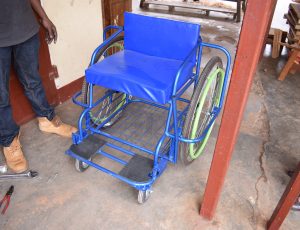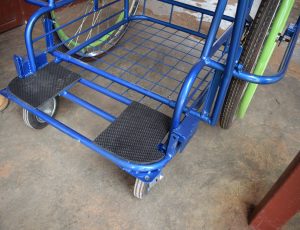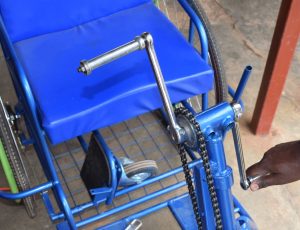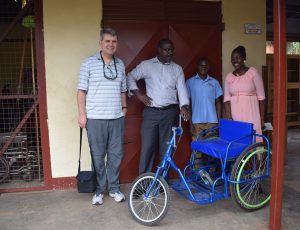Prototype 1 originated from a capstone project by fourth-year student Jennifer Vandermeer in 2013. While in the Kasese district of Uganda, Jennifer realized that in order for local children with disabilities to attend schools, they needed a mobility device that could both carry them over the rough rural terrain in order to get to school and that was small enough that it could easily maneuver within an indoor setting once they arrived. In order to make it so that students did not need two devices in order to attend school, Jennifer set out to co-design a mobility device that could transform from a tricycle and a wheelchair.
The tricycle needed to be durable and user-friendly for trips across uneven roads, and the wheelchair needed to be compact enough to move as easily as possible in tight quarters indoors. Prototype 1 was an extension of Jennifer’s initial designs, as the Lab, including local artisans and the non-profit CanUgan, saw value in furthering development of this device. CanUgan, for instance, was already working on importing tricycles that were manufactured elsewhere. However, importing devices is expensive, and they are generally not built for the specific terrain they end up being used in, which means they might break down more easily. This project’s intention to work with local artisans to design and manufacture the devices in Uganda w
Prototype 1 of the wheelchair-tricycle was originally built in Uganda after instructions and designs were developed in Ottawa. Navin Parekh of CanUgan travelled to Uganda in 2017 with designs for the manufacturer, Katalemwa Chesire Home, a disability-focused holistic rehabilitation hospital in Uganda. The purpose of this step was to see how effectively the designs could be communicated and the product reproduced at a distance.
When Bjarki Hallgrimsson, this project’s lead, arrived in the region a few months later to review the prototype that had been built, not only had the instructions been followed—meaning this step was successful—but the initial model had been improved upon by the manufacturer. The Ottawa designers learned a lot from the modifications that had been made.
The manufacturers at Katalemwa had added more substantial, stronger foot support so users would have a more sturdy base when getting in and out of the wheelchair.
Additionally, the initial designs had used a larger front wheel, about the size of a regular bike wheel. The manufacturer replaced it with a much smaller front wheel, making it easier to move the tricycle uphill, as well as making the fork less likely to bend, which would cause the chain to fall off. Bjarki and the designers took the redirections back to Ottawa ready to explore Prototype 2.




